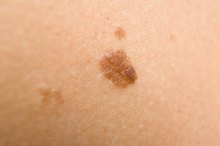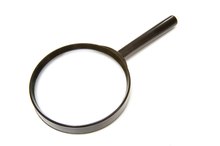What does fact checked mean?
At Healthfully, we strive to deliver objective content that is accurate and up-to-date. Our team periodically reviews articles in order to ensure content quality. The sources cited below consist of evidence from peer-reviewed journals, prominent medical organizations, academic associations, and government data.
The information contained on this site is for informational purposes only, and should not be used as a substitute for the advice of a professional health care provider. Please check with the appropriate physician regarding health questions and concerns. Although we strive to deliver accurate and up-to-date information, no guarantee to that effect is made.
Why Is a Mole Raising Up on Skin?
Moles in and of themselves are harmless; theyâ? ?re simply a pigmented lesion called â? ?melanocytic neviâ? or â?
?pigmented nevi.â? They can be flat or raised, depending on where the pigmented cells gather in the layers of your skin.
The danger is when previously flat moles become raised or raised moles change shape or grow larger. Possible causes include melanoma, a dangerous form of skin cancer, notes the New Zealand Dermatological Society.
Mole Characteristics
Moles can be as small as a pencil tip or as large as a quarter, ranging in color from light pink to brown to black. Some people are born with them, while other moles appear during infancy.rnrnThe New Zealand Dermatological Society classifies flat moles as junctional nevi, formed where the outer and inner layers of skin meet. Raised moles, called dermal nevi or compound nevi, form through a cluster of cells in the dermis and cause a raised bump in the skin.rnrnAccording to the American Academy of Dermatology, light-skinned people have an average of 10 to 40 moles.
Types of Moles
Small Bumps All Over the Legs That Are Flesh Colored
Learn More
If you were born with your moles, theyâ? ?re called â? ?congenital nevi.â? The American Academy of Dermatology reports that 1 in 100 babies are born with moles. Large congenital moles that are bigger than 20 centimeters in diameter carry a greater risk for skin cancer. rnrnSo-called â? ?atypical molesâ? develop after birth and can be a mixture of red, pink and brown colors. These are also skin cancer risks. â?
?Acquired molesâ? also develop after birth but are more regular in color and generally arenâ? ?t cause for alarm, states the American Academy of Dermatology website.
- If you were born with your moles, theyâ?
- ?
- atypical molesâ? develop after birth and can be a mixture of red, pink and brown colors.
Moles that Change Color or Texture
If you notice a mole that changes its color, shape or texture, see a dermatologist as soon as possible.rnrnMoles are caused by extra melanocytes, the pigment cells responsible for color. A form of skin cancer called malignant melanoma can form in or near these melanocytes.
When the cancerous cells begin expanding, the mole can change shape or color.rnrnSkin cancer isnâ? ?t the only possibility; however, your mole might be changing temporarily because itâ? ?s irritated by contact with a razor blade, chemicals in a lotion or sunscreen, or scratchy clothing.
- If you notice a mole that changes its color, shape or texture, see a dermatologist as soon as possible.rnrnMoles are caused by extra melanocytes, the pigment cells responsible for color.
Removing Moles
White & Dark Circles on Skin
Learn More
Your doctor may need to remove all or part of the mole to determine whether itâ? ?s cancerous. Even if a visual exam confirms nothing is wrong, you can have a mole removed for cosmetic reasons.
Doctors can perform a shave excision to cut out small moles or excisional surgery to remove larger moles along with some of the surrounding skin. The latter option is used to remove cancerous moles and in most cases, the moles never reappear, according to the Mayo Clinic 2.
- Your doctor may need to remove all or part of the mole to determine whether itâ?
- ?
- The latter option is used to remove cancerous moles and in most cases, the moles never reappear, according to the Mayo Clinic 2.
Skin Exam
The American Academy of Dermatology recommends performing self-exams to evaluate the condition of your moles. Donâ?
?t worry if some of your moles look different than others.
Just evaluate each mole based on how it looks now versus the last time you checked.
Look for the ABCDs: asymmetry, a changing border, changing colors, and diameter. If you see significant changes in one or more features, consult a dermatologist for a skin cancer screening.
- The American Academy of Dermatology recommends performing self-exams to evaluate the condition of your moles.
- Just evaluate each mole based on how it looks now versus the last time you checked.
Related Articles
References
- DermNet NZ: Moles
- Mayo Clinic: Moles: Treatments and Drugs
- American Cancer Society. Key statistics for melanoma skin cancer. Updated August 14, 2019.
- Children's Hospital of Philadelphia. Congenital nevus (mole).
- U.S. National Library of Medicine Genetics Home Reference. Are moles determined by genetics? Updated December 2017.
- National Cancer Institute. Genetics of skin cancer (PDQ) - health professional version. Updated January 3, 2020.
- American Society of Clinical Oncology. Melanoma: symptoms and signs. Updated January 2019.
- Skin Cancer Foundation. Melanoma warning signs. Updated April 2019.
- National Cancer Institute. Melanoma risk assessment tool.
- American Cancer Society. How to Spot Skin Cancer. Updated 07/06/17. https://www.cancer.org/latest-news/how-to-spot-skin-cancer.html
- Canadian Cancer Society. Signs and Symptoms of melanoma skin cancer. http://www.cancer.ca/en/cancer-information/cancer-type/skin-melanoma/signs-and-symptoms/?region=on
Resources
Writer Bio
Jenni Wiltz's fiction has been published in "The Portland Review," "Sacramento News & Review" and "The Copperfield Review." She has a bachelor's degree in English and history from the University of California, Davis and is working on a master's degree in English at Sacramento State. She has worked as a grant coordinator, senior editor and advertising copywriter and has been a professional writer since 2003.








